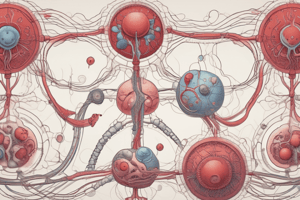Podcast
Questions and Answers
What is the primary function of the nasal cavity in the respiratory system?
What is the primary function of the nasal cavity in the respiratory system?
- To interrupt respiration when swallowing
- To filter out dust and other small particles from the air (correct)
- To expand the chest cavity
- To produce sound
What happens to the diaphragm during inhalation?
What happens to the diaphragm during inhalation?
- It contracts and moves upward
- It expands and moves outward
- It moves upward and relaxes
- It tightens and moves downward (correct)
What is the role of the larynx in the respiratory system?
What is the role of the larynx in the respiratory system?
- To aid in closing the epiglottis
- To interrupt respiration
- To filter out air
- To produce sound (correct)
What is the function of the intercostal muscles during breathing?
What is the function of the intercostal muscles during breathing?
What happens to the air when you breathe out?
What happens to the air when you breathe out?
What is the role of the pharynx in the respiratory system?
What is the role of the pharynx in the respiratory system?
What is the function of the epiglottis in the respiratory system?
What is the function of the epiglottis in the respiratory system?
What is the primary function of the mouth in the respiratory system?
What is the primary function of the mouth in the respiratory system?
Study Notes
Breathing Process
- Breathing delivers oxygen and removes carbon dioxide from the body
- Oxygen is carried in the blood to all cells and carbon dioxide is removed through exhalation
Mechanism of Breathing
- Inhalation:
- Diaphragm tightens and moves downward to provide more space for lungs to expand
- Intercostal muscles help widen the chest cavity
- Air enters through the mouth and nose, passes through the windpipe, and into the lungs
- Exhalation:
- Diaphragm moves upward and relaxes
- Intercostal muscles relax and chest cavity decreases in size
- Carbon dioxide is pushed out of the lungs and windpipe, and exits through the nose or mouth
Parts of the Respiratory System and Their Functions
Nasal Cavity (Nose and Mouth)
- Nose: normally used for inhalation, with tiny hairs (cilia) that act as a filter to catch dust and particles
- Mouth: used for breathing when more air is needed, especially during intense activity
Pharynx and Larynx
- Pharynx: the opening behind the nose and mouth, where air and food pass through
- Lined with tissues called tonsils, which can partially obstruct the passage of air or food
- Ends at the esophagus
- Larynx (voicebox):
- Houses vocal chords and muscles used in producing sounds
- Epiglottis found above the larynx, aids in closing it tightly to prevent food passage
Trachea and Bronchi
- Trachea (windpipe):
- Tube responsible for directing air into and out of the lungs
- Divides into two tubes at the end
- Bronchi:
- Have several branches called bronchioles
- Lead to air sacs called alveoli, where most gas exchange occurs
Lungs
- Cluster of bronchioles and alveoli, blood vessels, and elastic tissue
- Main function: to transfer oxygen into the bloodstream and excrete carbon dioxide into the air
Studying That Suits You
Use AI to generate personalized quizzes and flashcards to suit your learning preferences.
Description
Learn about the process of breathing, gas exchange, and the role of lungs in delivering oxygen and removing carbon dioxide from the body.




